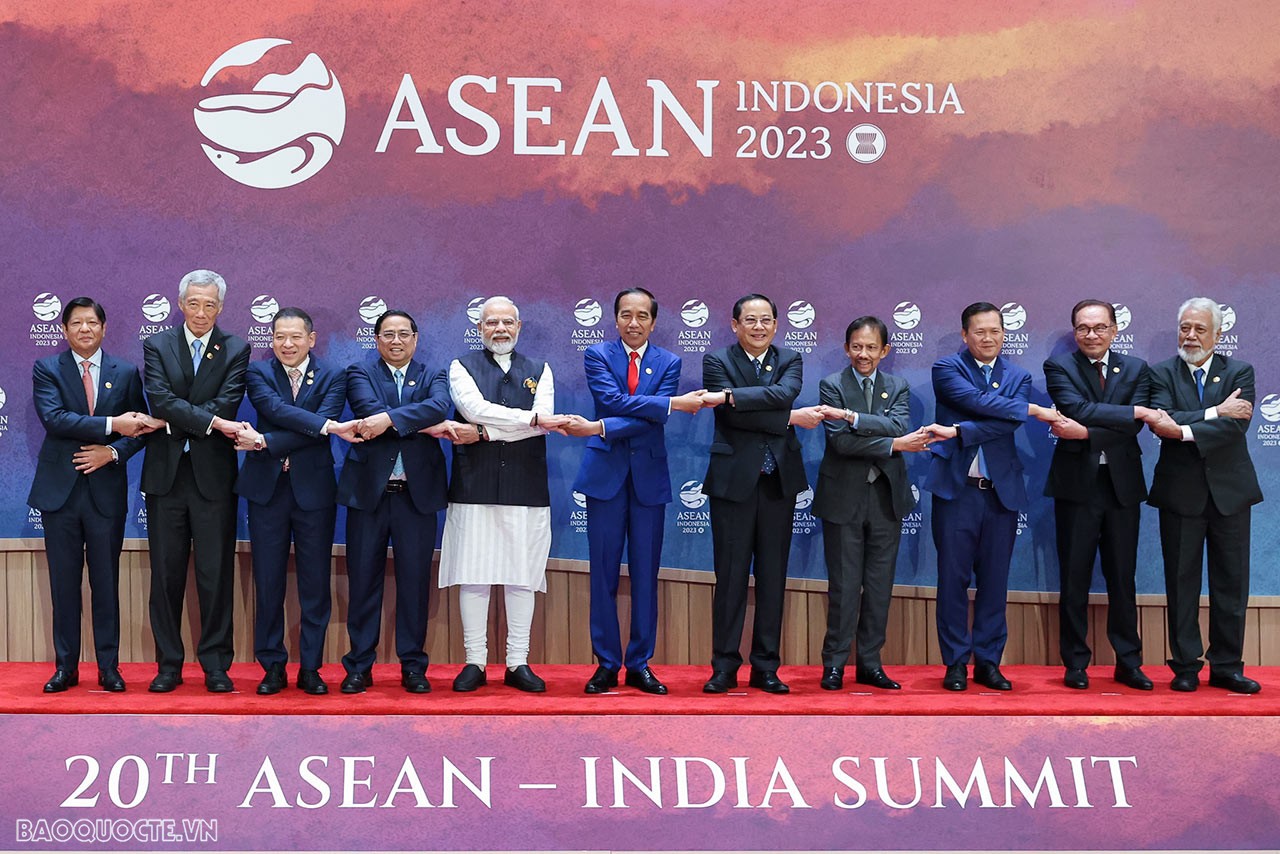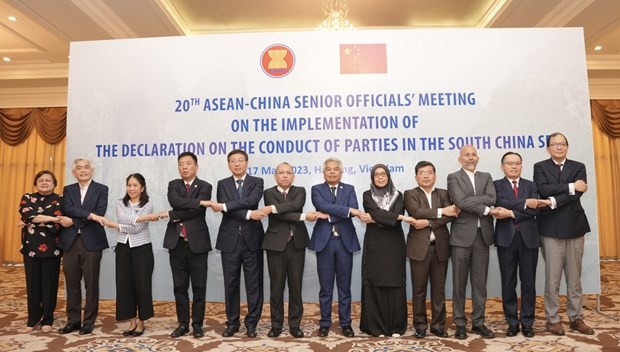
ASEAN’s challenge: Managing the South China Sea dispute
Latest
The South China Sea has long been a focal point of global concern due to escalating superpower tensions, territorial disputes, and China's belligerent posture in the region, which was recently manifested in China’s issuance of a new map claiming more areas in the South China Sea. The map, which also illegally claims parts of India, invited furious responses from Malaysia, Indonesia, the Philippines, and India.
 |
| Delegates attending the 20th ASEAN-India Summit as part of the 43rd ASEAN Summit in Jakarta, Indonesia on September 7, 2023. (Photo: Anh Son) |
China’s two-fold strategy of trying to engage Association of South East Asian Nations (ASEAN) member states in a protractive dialogue on CoC (Code of Conduct in South China Sea), while relentlessly pursuing its salami slicing, island reclamation, and increasing Gray zone activities in the South China Sea pose a challenge to regional stability, which has direct implications for ASEAN especially in the context of its ability to address the issue in a peaceful manner.
China's Gray Zone Tactics in the South China Sea intensified under the leadership of President Xi Jinping. Since 2013, China has made significant advances in its island reclamation and militarisation activities. It is increasingly resorting to the use of maritime militia in intimidating ASEAN claimant States, the latest episode being the one in which the Filipino coast fuards had to face the Chinese water cannons in these troubled waters.
The deployment of water cannons against the Philippines sparked international condemnation, prompting strong protests from Manila. China further escalated tensions by releasing a controversial map that included almost the entire South China Sea, East China Sea, Taiwan, and the sections encompassing vast territories including that of India. China’s unwillingness to address the concerns raised by Southeast Asian claimants, increasing United States (US) involvement to protect South China Sea as a global common has led to heightened tensions in the region.
Historically, most of the ASEAN member States have employed ‘hedging’ as a strategy in dealing with China, while collectively ASEAN has preferred ‘conflict avoidance’ and ‘conflict management’ has its twin tools to manage the South China Sea dispute. Both these strategies have yielded sub-optimal results in controlling China’s behaviour especially its unilateral actions in the South China Sea.
While China has emerged as the most important trade partner for ASEAN countries, the US has remained a crucial security partner for many of the littoral states, with key European Union (EU) countries, Japan, Australia, and India also acting as important security stabilisers in the region. Swiftly changing geopolitical dynamics have led to shifted perceptions about China, which was aptly reflected in the Singaporean Prime Minister (PM) Lee Hsien Loong’s statement at the Asia Future Summit on October 5, 2023.
 |
| The 20th ASEAN-China Senior Officials' Meeting on the Implementation of the Declaration on the Conduct of Parties (DOC) in the East Sea (SOM-DOC) was held in the northern province of Quang Ninh on May 17, 2023 after nearly two years of hiatus caused by the COVID-19 pandemic. |
He stated, “the Americans have been dominant in this region, while giving countries space to grow, to develop, to compete with one another peacefully and not to be held down or squatted upon. And that is why they are still welcomed after so many years. And if the Chinese can achieve something like that, I think the region can prosper.”
This statement encapsulates the perception ASEAN and most of its members hold about both China and the US.
China's growing aggression is increasingly seen as an immediate security concern, while doubts about the US as a credible partner have also resurfaced. For one, Joe Biden’s absence from the East Asia Summit in Jakarta did not go unnoticed in the ASEAN circle. ASEAN remains hesitant to openly align with the US even though economic interdependence and concerns about triggering tensions with China continue to hinder ASEAN’s efforts.
Furthermore, the bloc encounters difficulties in presenting a cohesive stance to safeguard its shared interests.
Following the release of the map, ASEAN did not issue a single joint statement. Instead, several member countries issued their own individual statements. Under the leadership of Bongbong Marcos, the Philippines has embraced a more assertive foreign policy towards China and is revaluating its alliance with the US.
That Southeast Asian countries find themselves in a dilemma when dealing with China and remain cautious and flippant in expressing their stance on the South China Sea is understandable The Malaysian PM Anwar Ibrahim’s recent statement in this regard is a case in point. Malaysia was critical of China after the latter issued its ‘new’ map. However, later, PM Anwar found China’s explanations ‘reassuring’. This state of uncertainty and dilemma stems from China’s actions, which involve both asserting its territorial claims and simultaneously (pretending to) demonstrate a genuine commitment to resolving differences. This is one of the reasons why any statement or attempts to quell the concerns of the Southeast Asian countries is often accepted without significant resistance.
Nonetheless, ASEAN is seemingly transitioning into a phase marked by doing more than just hedging vis-à-vis China. Growing bilateral and multilateral defence and security engagements with the US, Japan, the EU, Australia, and India, while concurrently attempting to forge a unified ASEAN stance demonstrate the approach. “ASEAN Solidarity Exercise” – the inaugural joint ASEAN-level military exercise and launch of the ASEAN Maritime Outlook showcase ASEAN’s resolve to be more mindful of the challenges it has been facing in South China Sea as well as the wider Indo-Pacific region.
Chinese leader Yang Jiechi’s 2010 statement regarding the power differential between China and Southeast Asian nations remains relevant to this day. As the then foreign minister of China, he declared during his address to the ASEAN Regional Forum in Hanoi, Vietnam, “China is a big country, and other countries are small countries, and that’s a fact.” The China challenges are prompting many countries in the region to reconsider their stance towards China. China’s activities in the SCS could potentially serve as a cautionary example of how to erode the goodwill of countries that once had a friendly approach towards China.
While ASEAN acknowledges the challenges posed by China, finding a satisfactory approach to resolve the SCS dispute remains elusive. Individual member states increasingly rely on external partnerships and formulate individual responses. However, the ultimate resolution to the South China Sea issue and the China dilemma must come from within the ASEAN bloc itself.
* Author, Rahul Mishra is Principal investigator, Indo-Pacific Research and Outreach Programme and coordinator, European Studies Programme at the Asia-Europe Institute, Universiti Malaya, Malaysia. This article was first published on The Hindustan Times.
(The views expressed are personal)









